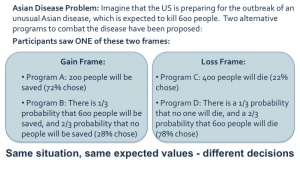“The way things are stated or portrayed, highly influences our choices”
Equivalence framing is the purposely stating or portraying of – logically equivalent – information in such a way, that it encourages certain interpretations of the meaningful context, and discourages certain others. These “different, but logically equivalent frames” cause us to alter our preferences. Equivalency frames are often worded in opposite terms. Like “gains” versus “losses”, “full” versus “empty”, “fat” versus fat-free”, et cetera.
Unlike emphasis framing (which focuses on different information), equivalence framing focuses on the same information, and tries to phrase that information in the most persuasive way.
Scientific research example:
Loss aversion (see under ‘Emotions’) is a clear example of framing (see also Emotions – ‘Loss Aversion’):
Imagine that your country is threatened by the outbreak of an unusual disease. There are 2 possible programs to combat the disease with different effectivity estimates. In a group of 600 people,
- Program A1: “400 people will die”
- Program B1: “there is a 1/3 probability that nobody will die, and a 2/3 probability that 600 people will die”
Which one would you choose?
Tversky & Kahneman (1981) found that most (78%) of us choose B in this so called ‘Asian Disease Problem’. However if the choice was framed as gains (saved lives) rather than losses (deads), people suddenly prefer Program A: In a group of 600 people,
- Program A2: “200 people will be saved”
- Program B2: “there is a one-third probability that 600 people will be saved, and a two-thirds probability that no people will be saved”.
Online Persuasion tips:
[checklist]
- List all your product features and branding aspects (or at least the most important ones) and for each feature / attribute think about how you can word it in opposite terms (e.g. “35% fat” versus 65% fat-free”)
- Now choose the phrasing that is generally the most persuasive
- And finally try to find out the needs for each specific customer (e.g. find out whether he is aiming to lose weight, or craving for a greasy burger, by using his Google searches, scraping his social updates, checking the subjects he read, et cetera), and start targeting with opposite equivalent frames
[/checklist]
A/B Test:
The online bank MoneYou wanted to have its customers open extra saving accounts. They tested whether it makes a difference to frame this action as:
- “For every savings target: an extra saving account”
- “For every savings target: a separate thrift-box”
The 2nd one raised the number of customers that checked into their personal banking account with 33% (they were unfortunately not able to measure the truly opened extra saving accounts).
Further reading on Equivalence Framing:
- Framing_(social_sciences) on Wikipedia
- Tversky, A. & Kahneman, D. (1981): The framing of decisions and the psychology of choice. Science, 211, 453 – 458.



